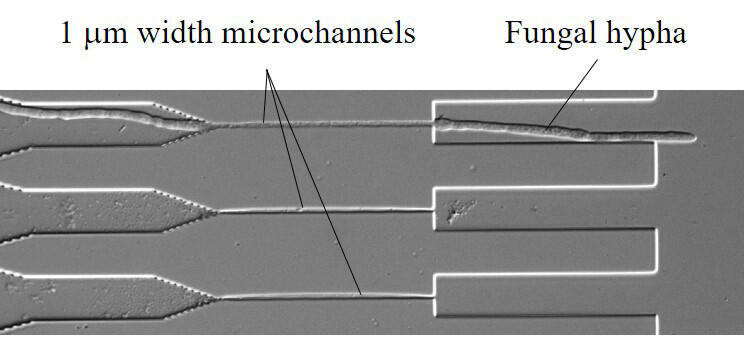The research group led by Associate Professor Norio Takeshita, Microbiology Research Center for Sustainability (MiCS), Faculty of Life and Environmental Sciences, University of Tsukuba, and Designated Associate Professor Yoshikatsu Sato, Institute of Transformative Bio-Molecules (WPI-ITbM), Nagoya University, has constructed a microfluidic device with 1 μm-width channels, which are narrower than the diameter of a fungal hyphae. Analyzing the forced morphological changes of growing hyphae, they discovered a relationship between the ability of filamentous fungi to pass through these narrow channels and their growth rate.

(Credit: University of Tsukuba)
Filamentous fungi (mold) are made up of tubular cells called "hyphae." The hyphae tips enter into the substrate of host cells and grow or arborize there. They are associated with the breakdown of biomass, a parasitic or symbiotic relationship with animals and plants, and fermentation among others. In order to enter a space that is smaller than their diameter, they need to change their morphology (or "plasticity"), but this has been difficult to analyze to date due to the narrow width of the hyphae cells, at just a few μm across. According to Takeshita, "Based on the paper by Dr. Sato demonstrating the ability of plant cells to pass through narrow channels using a microfluidic device with 1 μm-width (and 50-100 μm long), we decided to try the same thing with filamentous fungi."
Using live-cell imaging, the team analyzed seven fungal species (model filamentous fungus, Aspergillus, Neurospora crassa, two types of plant-pathogenic fungi, Zygomycota, and Basidiomycetes) from different lineages under the microscope. They found that some fungi could pass through the narrow channels and some could not. They also found that the ability to pass through the channels had nothing to do with the width of the hyphae, nor did it correlate with phylogenetic distance. Rather, the correlation was to the speed of hyphae growth. The slow-growing hyphae were highly elastic, able to change their cell shape to pass through the channels, but the fast-growing was slow to change and found difficulty in passing through the channels.
From this, the fact that fast-growing filamentous fungi may be able to quickly dominate new nutrition sources and spaces, yet have little ability to change to maintain the cell morphology to grow into extremely narrow channels, suggested a trade-off between morphological plasticity and velocity in mycelial growth.
Associate Professor Takeshita explains that, "Filamentous fungi are a microbe that exist everywhere in the natural world. As a decomposer of biomass such as dead trees, they provide an essential service to the ecosystem. Their growth plays a key role in everything from fermented products like sake rice wine, soy sauce and miso, to useful enzymes and bio-industries such as antibiotics manufacturing, and they are also symbiotic with the roots of plants. Some of these microbes can also cause mold contamination in housing, food and other materials. We hope to use new technologies like the microfluidic devices and high-resolution microscopes to find out more about the varied lives of filamentous fungi."
This article has been translated by JST with permission from The Science News Ltd.(https://sci-news.co.jp/). Unauthorized reproduction of the article and photographs is prohibited.




